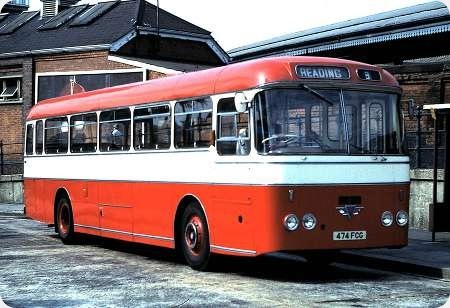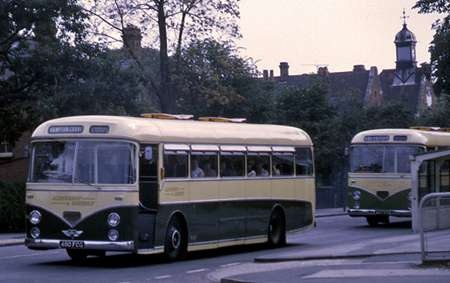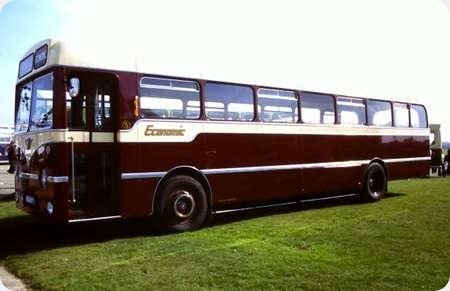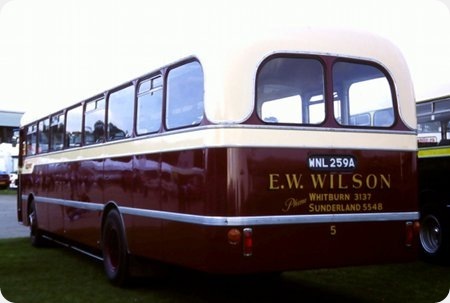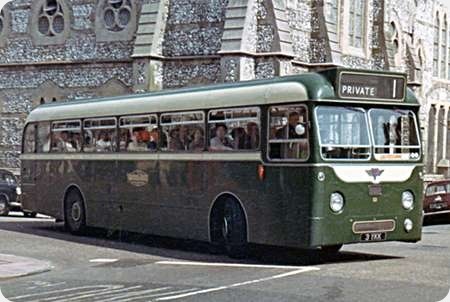Chiltern Queens – AEC Reliance – 474 FCG
Chiltern Queens
1963
AEC Reliance 4MU3RA
Park Royal C49F
This AEC Reliance of Chiltern Queens is seen outside Reading General Station on 9 September 1981. I don’t know anything about her, but I suspect she came from Aldershot & District. I’m sure someone will advise.
Photograph and Copy contributed by Pete Davies
24/09/15 – 06:07
Yes, this is one of the batch of fifteen such vehicles delivered to Aldershot & District in 1963, though the first one, 466 FCG, was displayed at the 1962 Earls Court Show. A&D always had a small engine policy, and these 36ft long coaches had the 7.685 litre AH470 engine driving through the Thornycroft designed six speed constant mesh gearbox. The correct chassis designation for these vehicles is 4MU4RA. Despite their modest power, these coaches were nice to drive provided one took the trouble to treat the gearbox with respect. In 1966 came a further batch of five 49 seat Reliance coaches of very similar appearance, though this time the bodies were built by Weymann, and the 6MU3RA chassis employed the then new 8.2 litre AH505 engine driving through the AEC five speed synchromesh gearbox. The picture shows the last of the earlier batch, 480 FCG, in a dark green and cream livery, leading 467 FCG through Farnborough on an excursion to Hampton Court in 1969. This must have been a hot day as both vehicles are in motion with the doors open, a practice that was then, as now, illegal.
Roger Cox
24/09/15 – 16:17
Thank you, Roger. It has always puzzled me a bit that Chiltern Queens, as with a number of other operators, had completely different liveries for buses and coaches, rather than the ‘reversed’ style. Their choice, of course!
Pete Davies
24/09/15 – 16:18
I’m sure Roger Cox knows a lot more than me about these things, but was it illegal to have the doors open while in motion? Some London Transport RFs had no doors while plenty of rear entrance deckers had either no doors or had manually operated ones that were rarely closed especially on town services.
Nigel Turner
24/09/15 – 16:19
Roger’s comment about the legality of running with doors open highlights the sometimes absurdity of UK legislation when one considers that the Metropolitan Police for years banned doors on another type of front entrance single decker – LT’s Central area RFs
Phil Blinkhorn
25/09/15 – 06:30
Comparing the two photos in this thread, someone had done a great deal of work changing the trim and the window vents.
Phil Blinkhorn
25/09/15 – 06:30
These have a passing resemblance to some Roe bodied Reliances of at around the same time although they were 30ft dual entrance examples.
The Metropolitan Police were a very conservative outfit being reluctant to sanction pneumatic tyres covered tops and even cab doors!
Chris Hough
26/09/15 – 06:00
On the question of doors on buses, the regulation seems to have been that, if fitted, these had to be closed when vehicles were in motion. This then raises the matter of conductor/hand operated doors at the rear of double deckers so fitted, which were regularly seen open in service owing to the impracticability of the conductor being able to operate them at every stop. In real life, the rules seem to have been enforced as much by each company’s disciplinary system as by the law. In London, the Metropolitan Police were always reactionary in their non acceptance of new engineering technology. To the list given by other contributors may be added four wheel brakes.
Phil has raised an interesting point about the greatly modified trim and fittings worn by the Chiltern Queens machine. A&D were very fond of Auster windows as seen on the Reliances in their original form, but replacing these with sliding vents would not have been a major task. The bodywork is another matter, however, and one wonders why anyone would go to such trouble. Not only have the trim lines been repositioned and the bumper removed, but the headlamps have been repositioned also. Unless this vehicle suffered front end damage necessitating a rebuild at some point in its life, the whole exercise must have been of decidedly dubious cost effectiveness.
Roger Cox
27/09/15 – 05:48
Looking around on Flickr the history of 474 FCG is confusing. It ran originally with headlamps as delivered to Aldershot and District but was later rebuilt as Roger noted and seen above. In the early shots the ventilators have all been replaced but in at least one later shot it had managed to acquire one of the Auster vents back. They also had 478 FCG (at least) which had the headlamp modification too, but on which only half the ventilators were replaced. It’s worth noting that both had their original coach seating replaced by bus seating.
David Beilby
27/09/15 – 05:49
If you look at the photo of the Chiltern Queens vehicle carefully, you will see that it has also been fitted with two piece power doors. The front dash appears to be a replacement of the original. I am therefore wondering if A&D (or AV) did in fact carry out the modifications themselves, when the vehicle was downgraded from coach work?
Ironically, the Captcha code I had to enter here included the letters "DP"!
Nigel Frampton
28/09/15 – 07:02
Initially, I thought that the 4MU3RA chassis designation in the heading was an error, as this batch of coaches were delivered to A&D as the 4MU4RA type. However, given the extensive alterations subsequently made, I wonder if the Thornycroft six speed constant mesh gearbox in 474 FCG might have been replaced with the five speed AEC synchromesh box, which would have been much easier to use on normal bus work.
Roger Cox
29/09/15 – 07:02
Looking through Buses magazine April 1975, under Alder Valley it was reported that "AEC Reliance 338 (474 FCG) a 1963 vehicle with Park Royal DP49F bodywork has been sold to Chiltern Queens, Woodcote". Buses magazine also records further ‘FCG’ withdrawals in 1976: 336 (472 FCG) with C49F bodywork, which went to the Transport and Road Research Laboratory (TRRL), Crowthorne; 337/8 (473/80) also reported as C49F; fire-damaged 370 (466 FCG) which was recorded as being DP49F. It would appear that some of the batch were converted at some point to dual-purpose vehicles, which may explain the revised trim on 474 FCG. However, on Flickr ‘hivemind’ there are two photos which show 474 FCG operating for Chiltern Queens with and without folding doors. Unfortunately they are both offside shots, but no folding doors are visible on the black and white photo, whereas they are on the colour view. So it would appear that the powered door conversion, and probably the bus seats conversion, were carried out while the Reliance was with Chiltern Queens. Unless as the saying goes "someone knows otherwise!".
Reliance 474 FCG can be viewed at this link:
//flickrhivemind.net/Tags/474fcg,parkroyal/Interesting
Brendan Smith
03/10/15 – 13:37
On the question of the legality of leaving doors open while the bus was in motion, I have no idea. The LT Central area RFs were without doors and I was working in the PSV section of the Metropolitan Traffic Area in 1963 or 1964 when a call came through saying that a passenger had been killed alighting from an RF while the bus was moving. At that time, it was common for many, usually male, passengers to jump off as the bus was coming to a stop. That was OK with rear entrance and forward entrance vehicles, but the front entrance RF was turning left at the time and the front nearside wheel was sticking out and caught the poor man before the driver could stop. Horrible! I only hope it was quick.
David Wragg
07/10/15 – 06:29
This might be something on which Chris Youhill could comment: in response to complaints about poor ventilation/over-heating in Leeds’s (fixed/panoramic-windowed) 33ft "Jumbos"/"Tommy Lord Boxes" the GM, Tom Lord, informed the "Evening Post" that in hot weather drivers would be allowed to run with the front doors open . . . a stiff reprimand from the Traffic Commissioner’s Office followed.
Philip Rushworth
07/10/15 – 15:49
Talking about poor ventilation, last year I travelled on a new Blackpool tram. It was May and not an unduly warm day, but the tram was uncomfortably warm and I noticed the conductors were in shirts//blouses. When I remarked that aircon would have been useful, especially as it was electrically driven, they said that the drivers’ cabs were going to be fitted with it, but not the passenger compartments!
Chris Hebbron
08/10/15 – 07:20
That’s quite correct, Mr Hebbron – the passengers don’t matter to most operators. After all, they only keep the firm going and pay the wages!
Pete Davies
09/10/15 – 07:24
Neither do they care about the conductors, Pete D, who have to work on the trams all the time, whereas the passengers do, at least, get on and off!
Chris Hebbron
Quick links to the - Comments Page - Contact Page - Home Page
